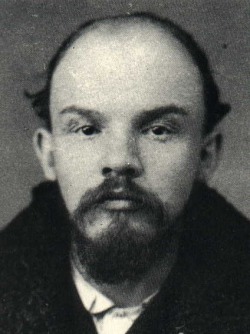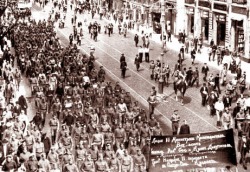Return to the Rise of the Soviet Union Homepage
Russian Revolutions of 1917
Causes:
Nicholas II adopted agrarian reforms and factory reforms however the peasants and workers were not pleased.
Social Causes: 85% of the Russian people were peasants. They were oppressed by the upper classes and the Czarist regime. Serfdom also described the social conditions in Russia under Nicholas. Serfdom was when a small class of noble landowners controlled a vast number of indentured peasants. Even though these peasants were freed in 1861 by Czar Alexander II of Russia, it was only because it was keeping Russia from advancing socially. The government then gave the peasants set amounts of land to cultivate; however, this greatly upset the peasants and as a result, many riots broke out. WWI also demanded war supplies which demanded more workers. This lead to even more strikes and riots. Due to the fact that more factory workers were needed, peasants moved into the cities, which became overpopulated. Additionally, food supply on the war front grew scarce and by 1917, the larger cities were in fear of famine.
Political Causes: Nicholas responded violently to many of the strikes and protests, an example was Bloody Sunday. The worst decision that was made by Tsar Nicholas in 1915, was when he took control of the army war front and left his wife to take care of the government by herself. In one year, the Russian army lost more than one million soldiers, another 2 million people were prisoners of war and one million had gone missing.
Economic Causes: During the war, 15 million men joined the army and this left an insufficient number of workers in factories and on farms. As a result, there was a widespread shortage of food and materials. People rioted for better conditions in the factories. There was one protest to which Nicholas II responded with violence; in response, industrial workers went on strike and immediately paralyzed the railway and transportation networks. The available supplies could not be transported and this greatly hurt the army. As goods became more and more scarce, prices skyrocketed. By 1917, famine threatened many of the larger cities. Because Nicholas ignored the economic problems in his country, the possibility of revolution was compromised.
The Provisional Government- The provisional government was set up to replace the Czar and his old government, and represent the people and bring changed to Russia. One of the main problems about this government was the war. The people of Russia wanted to be out of the war, but moderates of the the government wanted a continuation of the war.
Vladimir Lenin

"A revolution is impossible without a revolutionary situation; furthermore, not every revolutionary situation leads to revolution" - Vladimir Lenin
Stages of the Revolutions.

There were two main Revolutions in 1917. The first revolution in February overthrew the Russian Monarchy. The second revolution in October created the world's first Communist state.
There were four stages of the Russian Revolution
First Stage- Fall of Czar
Second Stage- Provisional Government formed
Third Stage- The return of Lenin
Fourth Stage-Bolsheviks overthrow the government
On 12 March 1917 Rodzianko, the President of the Duma, telegraphed the Tsar:
The situation is getting worse. Something has to be done immediately. Tomorrow is too late. The last hour has struck. The future of the country and the royal family is being decided.
The Tsar read it and said:
Again, that fat-bellied Rodzianko has written me a load of nonsense, which I won’t even bother to answer.
On 13 March the Duma forced Nicholas to abdicate.
